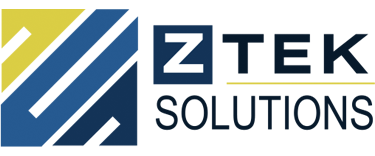Small Business Guide to Proactive Cybersecurity
In today’s digital landscape, cyber threats evolve faster than ever before. For many small businesses, a “wait until something breaks” approach is no longer sustainable. Threat hunting is the proactive process of identifying and eliminating potential security risks before they cause damage – a powerful way to stay ahead of attackers.
At ZTek Solutions, we help small and medium-sized businesses move beyond reactive support by integrating prevention, email security, and vulnerability management into a cohesive, proactive cybersecurity strategy.
Why Threat Hunting Matters for Small Businesses
Cybercriminals no longer focus only on large corporations. Small businesses have become attractive targets because they often lack advanced defenses, making them easier to breach. The cost of a cyber incident goes far beyond immediate repairs as it includes downtime, loss of customer trust, and potential regulatory penalties.
Threat hunting changes the equation. Instead of waiting for alerts, threat hunters actively look for indicators of compromise, abnormal network behavior, and potential weaknesses before an attacker can exploit them.
For small businesses, adopting this proactive mindset is the key to keeping operations running smoothly and data secure.
Why Prevention Is Key
Before you can hunt threats effectively, you need a stable and secure environment. Prevention is about creating the conditions that make it harder for attackers to succeed in the first place. That means patching systems, backing up data, and maintaining clear visibility over your network.
How ZTek Solutions Helps
- Proactive Monitoring: We continuously monitor your systems to detect unusual activity or signs of compromise early.
- Automated Maintenance: Regular updates, patching, and system optimization reduce your exposure to common vulnerabilities.
- Backup & Disaster Recovery: Verified, encrypted backups ensure that even in the event of a breach, your data and business continuity are protected.
- Asset Management: We track every device and system in your network to ensure nothing falls through the cracks.
By focusing on prevention first, ZTek Solutions helps you build a stable foundation for effective threat hunting and long-term security.
Email Security: The Frontline of Cyber Defense
More than 90% of cyberattacks begin with an email. Phishing campaigns, business email compromise (BEC), and malware-laden attachments can all serve as entry points for attackers. Threat hunters often start with email logs and access activity, because early warning signs frequently appear there first.
How ZTek Solutions Helps
- Advanced Email Filtering: Multi-layered defenses detect and block phishing, spam, and impersonation attempts.
- User Awareness Training: We educate employees to recognize suspicious messages, links, and attachments.
- Identity & Access Controls: Multi-factor authentication (MFA) and strong password policies prevent unauthorized access to email accounts.
- Incident Response: If an attack slips through, our team acts quickly to isolate the threat, restore security, and review the root cause.
By combining technology, monitoring, and training, we make your organization’s primary communication channel one of its strongest defenses.
Vulnerability Management: Finding Weak Links Before Attackers Do
Every network has weaknesses – unpatched software, misconfigured systems, or forgotten endpoints. Hackers exploit these gaps to gain access and spread silently through your environment. Vulnerability management identifies, assesses, and prioritizes these weaknesses before they can be used against you.
How ZTek Solutions Helps
- Regular Vulnerability Scans: We detect weaknesses across your entire network, from servers to workstations.
- Patch & Configuration Management: Our team ensures your systems stay updated and aligned with security best practices.
- Risk-Based Prioritization: Not all vulnerabilities are equal. We focus on the ones that pose the greatest threat to your business.
- Continuous Monitoring: Ongoing surveillance detects newly discovered vulnerabilities and ensures they’re addressed before they become a problem.
Effective vulnerability management is one of the strongest tools in a threat-hunting strategy, ensuring attackers have fewer opportunities to infiltrate your systems.
Turning Insight into Action
Threat hunting isn’t reserved for large enterprises with massive IT budgets. When prevention, email security, and vulnerability management work together, even small businesses can build a strong, proactive defense.
A simple threat-hunting process might include:
- Establishing a Baseline: Identify normal network activity, user behavior, and asset inventory.
- Monitoring for Anomalies: Watch for unusual logins, access patterns, or communication attempts.
- Scanning for Vulnerabilities: Continuously assess where weaknesses exist and prioritize fixes.
- Investigating Alerts: Trace unusual events to determine if they’re signs of compromise.
- Responding & Learning: When threats are found, contain them, document the findings, and improve defenses.
Why Choose ZTek Solutions for Proactive Cybersecurity
- Comprehensive Protection: We combine managed IT, cybersecurity, and consulting services into one integrated package.
- Proactive Mindset: Our approach focuses on prevention and detection not just reaction.
- SMB-Focused Expertise: We understand the unique challenges small businesses face and scale our solutions accordingly.
- 24/7 Monitoring: Around-the-clock visibility ensures you’re always protected, even when your team is off the clock.
- Experienced Team: With decades of combined experience, our team has the knowledge to secure, manage, and modernize your IT environment.
ZTek Solutions provides the tools, expertise, and strategy to help small businesses hunt threats before they strike.
Getting Started
Proactive cybersecurity begins with understanding your current environment. Start by asking:
- Are my systems up to date and regularly patched?
- Do my employees know how to recognize phishing attempts?
- When was the last time I reviewed my vulnerability reports or backups?
From there, ZTek Solutions can help you build a proactive plan that incorporates prevention, email security, and vulnerability management into your overall cybersecurity posture
In cybersecurity, waiting for a problem is no longer an option. By adopting a proactive approach and focusing on prevention, email security, and vulnerability management, small businesses can transform their defenses from reactive to resilient.
ZTek Solutions is a Managed Service Provider based out of Miami Lakes, FL has over 60 years of combined experience in designing, implementing, securing, and managing IT Infrastructure at all levels. Solutions include Managed IT, Cybersecurity, IT Consulting, Cloud Services, Structured Cabling, Video Surveillance, Telecommunications, and Compliance.







